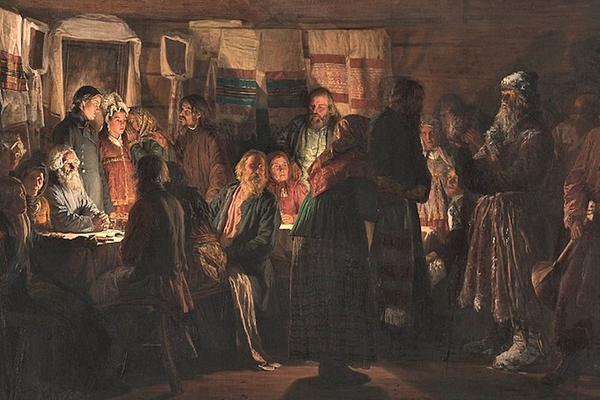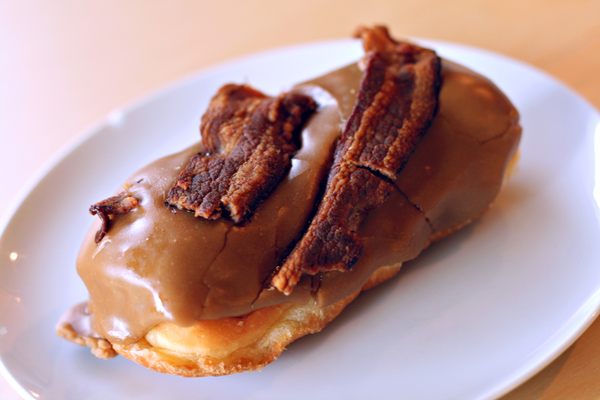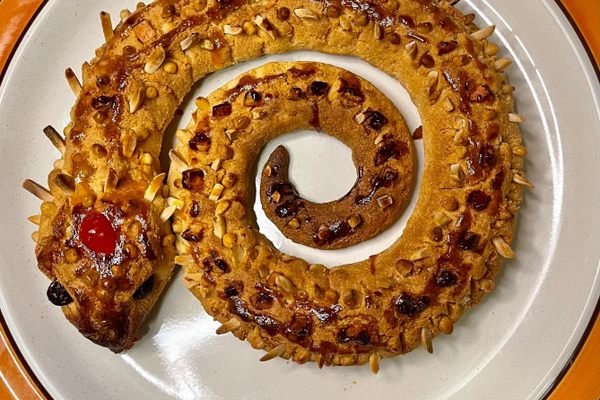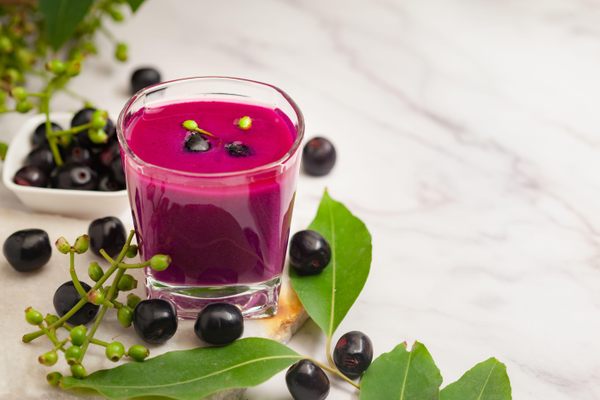The Forgotten Dessert Loved by a Roaring ’20s ‘It Girl’
When life gives you marshmallows, turn them into marlow.
THIS ARTICLE IS ADAPTED FROM THE SEPTEMBER 30, 2023, EDITION OF GASTRO OBSCURA’S FAVORITE THINGS NEWSLETTER. YOU CAN SIGN UP HERE.
A friend recently gifted me a recipe booklet from 1941 called Bananas … How to Serve Them. Published by the Meloripe Fruit Company, it features 56 banana recipes, as well as helpful tips like how to gauge a banana’s ripeness, and how to “flute” bananas to make them more presentable when serving (use a fork to draw lines down the sides of a peeled banana, then slice crosswise into “dainty crinkle-edged rounds.” Who knew?)
Many of the savory recipes in the book, like Banana Meatloaf and “Salmon Salad Tropical,” have been lost to history, for good reason. The desserts are more familiar to a modern palate—for the most part. Nestled among banana cream pies, milkshakes, and ice creams, something called Banana Grape Marlow caught my eye.
I didn’t know what marlow was, but the language of the recipe assumed that I would. I had stumbled upon one of the things that excites me the most about historical recipes: a forgotten commonplace food, something that feels like a novelty to me, but was once so familiar that it required no explanation.
To make marlow, you melt marshmallows on the stove, let them cool, and whip them into a foam with a small amount of cream, adding mashed fruit and juice for flavor. You don’t even need to add sugar because it’s already in the ingredients; just melt, whip, and freeze. Seeing how simple the procedure was, I knew that I had to try it.
The result tasted mostly of banana, with a subtle marshmallow-y sweetness. The grape and lemon juices I added weren’t noticeable at all. I found the texture similar to dairy ice cream, but a bit more dense.
The difference became more apparent as the marlow warmed. After 30 minutes at room temperature, while regular ice cream would have melted into a puddle, my marlow held its shape almost completely. Instead of fully liquefying, it became spreadable and spongy like marshmallow creme, even jiggling when tapped with a spoon.
Trying marlow only made me curious to learn more. Where did people get the idea of using marshmallows in this way? From how the dish was presented in the cookbook, I doubted that Meloripe Fruit Company was the first to make it (though I lay the blame for Salmon Salad Tropical squarely at their feet).

When you’re making ice cream or a similar frozen dessert, the last thing you want is for it to freeze completely solid. Churning or mixing is essential to achieve a scoopable texture, because it adds air molecules into the ice cream and prevents the formation of big, solid ice crystals. The continuous process freezer, precursor to the modern ice cream churn, was invented for commercial use in 1926, but it would be decades before similar products were available to home consumers.
Some of the banana ice cream recipes in Meloripe’s cookbook indicate that they can be made using a crank freezer, an early hand-powdered ice cream churn that used salted ice held in a separate compartment to lower the freezing temperature of the base. If you didn’t have one of these, another method was to simply take the base out of the ice box every few hours and stir it.
This method is employed in many vintage home recipes, like this 1930s Italian ice. However, in addition to being time-consuming, results from this method are still more dense than other methods, and won’t be totally uniform and smooth.
One way to improve the texture of a homemade ice cream is to make the base with ingredients that can be whipped into a stable foam before freezing, trapping air to maintain a light structure. Some modern “no-churn” recipes work this way, but it’s a technique that goes back to the earliest modern ice cream in the 18th and 19th centuries.
Many ice cream and sorbet recipes from this era included whipped heavy cream, raw egg whites, or some combination of the two, which hold air bubbles well because of their fat and protein molecules.
Marshmallow-based ice cream doesn’t seem like such a great leap, when you consider that the first marshmallows were made with egg whites. By 1900, marshmallows were being mass-produced with gelatin as a binder, which, like egg white, has the potential to form a dense structure because of its protein molecules.
In the 19th century, egg-white marshmallows were an artisanal treat to be savored. The proliferation of mass-produced gelatin marshmallows in the early 20th century allowed for lots of recipes made with them, and marlow became a home ice cream favorite.
You can find recipes for chocolate, mocha, strawberry, orange, pineapple, and other flavors of marlow in early- and mid-20th century cookbooks and womens’ magazines. Marlow became especially popular during WW2 food rationing, because most recipes needed no additional sugar. The name marlow seems to be simply derived from “marshmallow,” and variations have other names like “mallowbet.”
Marlow’s disappearance after the 1960s might be attributed to a movement away from highly processed sugary treats like marshmallows, as well as the availability of home ice cream machines that made texture-improving ingredients in ice cream recipes obsolete.

The oldest marlow recipe I’ve been able to find is also the most intriguing, because of its source. It was published in a 1933 edition of Photoplay, a major pop culture magazine that regularly featured the “recipes of the stars.” Made with milk, cream, vanilla extract, and 40 of what must have been small-sized marshmallows, this early marlow was submitted by none other than Clara Bow, one of the most-famous and influential movie actresses of her time.
Bow’s public persona epitomized the Roaring ‘20s flapper: carefree, flirtatious, and stylish. In 1927, she starred as the plucky heroine of a film called It, earning her the nickname “the It Girl.” That same year, Bow contributed a recipe to Photoplay for “chicken chartreuse,” made with minced chicken, rice, and tomato sauce. “Here’s a dish with lots of ‘IT,’” Photoplay promised. “Try it on the boy-friend.”
Over the next few years, Photoplay would publish several more recipes from Bow, such as a jellied tuna salad mold in 1929. Not that we should think of Bow as an early celebrity chef. During a 1931 visit to New York, she reported that the only person back in Hollywood whom she missed was her cook.
At the height of her fame, Bow retired from acting after her five-year contract with Paramount Studios expired, which had been her plan all along. Bow’s marlow recipe was released in the same year as Hoopla, her final film. By the time Photoplay readers were trying out Bow’s vanilla marlow, she and her husband, fellow movie star Rex Bell, had left Hollywood for a remote ranch in Nevada, where they would reside until their deaths in the 1960s. I wonder if Bow’s cook went with them.
Recipes like this offer us a small window into a different world; a world where Clara Bow was the biggest movie star and marlow was a popular after-dinner treat. As described in Bananas … How to Serve Them, your home might even have a newfangled “automatic refrigerator” with built-in freezing trays. A quirk of technology allowed marlow to become a household favorite, however briefly, but I do think this is one vintage recipe that stands up to scrutiny today, even if the flavor of the Meloripe recipe was a bit lacking. Next time, I’ll try Clara’s version instead.
Clara Bow’s Marlow Recipe
“Here’s what you’ll need: 40 marshmallows, 1 pint of whipping cream, 2 cups of milk and 2 tablespoons of extract of vanilla. Here’s how it’s done: Put the marshmallows and milk over hot water and steam until the mixture has melted. Add the vanilla and allow to cool. When sufficiently cold and showing signs of stiffening, combine it with the stiffly-beaten cream. Pour into trays and allow to freeze without stirring.”
Gastro Obscura covers the world’s most wondrous food and drink.
Sign up for our regular newsletter.

























Follow us on Twitter to get the latest on the world's hidden wonders.
Like us on Facebook to get the latest on the world's hidden wonders.
Follow us on Twitter Like us on Facebook